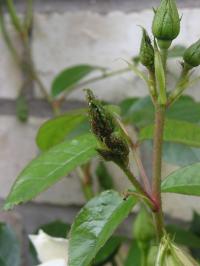Managing Aphid Infestations
 Aphid is general term given to greenfly and blackfly
Aphid is general term given to greenfly and blackflyAphids thrive in Summer, but what are the best ways to fight this common garden pest?
Early summer and aphid colonies start to build up in many gardens. This common garden pest is prolific in warm weather, and damp conditions also produce lots of lush green growth; ideal for aphids.
All plants are potential targets. Soil that is too rich also promotes excessive young growth; highly susceptible to aphid attack
Symptoms of aphid attack are quite easy to recognise, growth is often stunted and distorted. Foliage of plants that are under attack are often sticky, this is because they are covered in honeydew (the polite name for aphid excrement). The sticky leaves often develop black, sooty moulds on their surfaces. This is primarily a cosmetic annoyance but it also undoubtedly reduces the ability of the leaves affected to photosynthesise efficiently and therefore weakens the plant. All aphids types are also potentially problematic because they have the ability to spread plant viruses as they move from one plant to another.
Aphid is general term given to greenfly and blackfly but also to aphids coloured yellow, brown, pink or grey. All are about half a centimetre in length. Woolly aphid is identifiable by downy white wax substance (excrement again) that it secretes primarily on the branches of trees and shrubs.
Under glass, stick yellow traps can be hung above plants to catch flying adults that are attracted to the colour. There are companies that specialise in providing predatory insects, similar to aphids that will actually feed on the aphids under glass.
I prefer to try and control aphid colonies by using natural predators or other green techniques. Ladybirds and Lacewings are natural predators of aphids, the key to attracting such predators to the garden, that will feast on the aphid colonies is to use plants in the garden that will act like magnets to the predators.
The most affective plants are Marigolds. French Marigolds (Tagetes patula) planted in the vicinity of plants particularly susceptible to aphid attack will attract lots of hoverflies, that will in turn feast on the aphids. The hoverflies will also lay eggs on the aphid colonies and the hatching larvae will then eat the aphids. One reason that the Marigolds are particularly attractive to the hoverflies is because the flowers are very flat, providing an excellent landing platform for a rest before lunch. The Poached Egg Plant; Limnanthes douglasii is also particularly attractive to hoverflies,
A different type of Marigold; Pot Marigold (Calendula) is very useful in attracting Lacewings. The larvae of Lacewings feast on aphids so it is a good idea to try and attract them into the garden.
Another technique, if you are not too squeamish, which produces instant results is to simple rub off the aphid, squashing them between you thumb and forefinger.
Also worth a try, is to use a concoction of Rhubarb leaves, crushed Garlic and Chilli powder all boiled up together and left to cool as an organic control against aphids. Remember Rhubarb leaves are poisonous to humans!
If you donít want to use Ďgreení techniques to fight aphid attacks there are sprays that can be used. They usually contain bifenthrin, pyrethrum, derris, imidacloprid or pirimicarb. I would prefer to use the latter because it is selective; it wonít harm beneficial insects that also visit the plant such as bees and the previously mentioned Ladybirds and Lacewings.
So, tough summer months lie ahead in the battle against aphids, if you are happy to give the non-chemical techniques a go, it will be an excellent investment in your gardenís future, building a natural army to deal with one of the most common garden pests.
Filed under Pests & Diseases.

